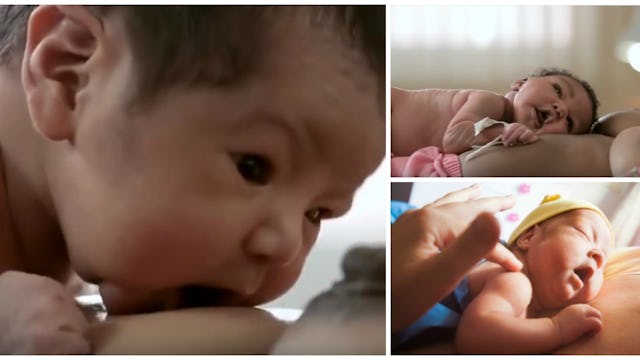I Did The 'Breast Crawl' With My Baby And It Was Amazing

The hours and days after my first baby was born were a blur of shock and tears and frustration. He and I were healthy, which was a blessing, but no matter what I did, I could not get him to breastfeed. He just wouldn’t open his mouth to latch on at all. It broke my heart and stressed me the heck out.
By the time my second baby was born, I was not only a more experienced breastfeeding mom (we finally did get my first baby to latch, after many tears and struggles), but I was a board certified lactation consultant (IBCLC) by then. Armed with experience and information, I was determined to have a better breastfeeding initiation experience this time.
One of the things that I think made it difficult the first time is that soon after my baby was born, he was whisked off to be bathed, examined, and given his Vitamin K shot. When it was time to prepare for my second baby’s birth, I had read all about the magic of the first hour after birth, and how babies are actually primed to breastfeed then.
I had even seen videos of babies doing the “breast crawl” after birth, where they literally scooted and crawled up to the breast, found it, and latched on – all by themselves.
I planned to do just that this time, and my midwives agreed that as long as the baby and I were healthy and well, he would have at least an hour to hang out on my chest before any bathing or tests were done.
Thankfully, after a quick and intense birth, my baby came out raring to go. We placed his slippery little self on my chest and waited. At first, he kind of just hung out there sniffing around, taking a few licks, and sort of just checking out the territory. Then, about 20 minutes later, I felt his little foot press into me and he started army-crawling up to my nipple, pecking around like a tiny little sparrow.
And then … he latched himself right on.
It was nothing short of a miracle as far as I was concerned. And it was really healing after my first experience. That kid never had any trouble latching on after that.
If at all possible, I encourage all new moms to try the breast crawl. Barring unforeseen medical conditions, almost all babies are capable of doing it, and it can be done whether full-time breastfeeding is your goal or not. It’s just a super cool experience – a great way to bond, initiate breastfeeding, and it’s empowering to see what your body and your baby can do.
How does the breast crawl work? Experts believe that babies are born with instincts they can tap into during that first hour after birth – and that these instincts help orchestrate the whole amazing phenomenon.
“All newborns, when placed on the mother’s abdomen soon after birth, have the ability to crawl to their mother’s breast and begin feeding on their own,” explains Vidya Kulkarni in an article for UNICEF. “The phenomenon is proving to be a breakthrough in overcoming commonly encountered problems in early breastfeeding.”
Breastcrawl.org describes newborns as being programmed like a computer with instructions to find the breast.
“It appears that young humans, like other baby mammals, know how to find their mother’s breast,” Breastcrawl.org explains. “The Breast Crawl is associated with a variety of sensory, central, motor and neuro-endocrine components, all directly or indirectly helping the baby to move and facilitate her survival in the new world.”
A newborn’s sense of smell, taste, and vision work in concert to locate the boob, they explain, and in general it takes newborn about 30-60 minutes for the whole she-bang to occur (so you have to be patient!). Moms can help their babies along if they feel compelled to. There are no real rules for how it should be done, only that your baby stays skin-to-skin with you, uninterrupted, right after birth.
In addition to increasing breastfeeding initiation rates, UNICEF says that allowing your baby to do the breast crawl encourages mother-infant bonding as well as a few other awesome benefits.
“It helps to keep the baby warm,” Dr. Gangal tells UNICEF. “The baby starts getting colostrums [first milk], which have high concentration of antibodies. This offers protection against infections and is important for the baby’s survival.”
“Mothers are benefited as well,” Dr. Gangal adds. “Breast crawl helps uterine contraction and faster expulsion of the placenta, reduces maternal blood loss and prevents anaemia.”
How freaking cool is all of this?
But you’ve got to see it to believe it. Check out this video which shows the incredible breast crawl in action. Warning: video may cause your ovaries to burst.
Does this just make you want to go out and have another baby just to get the do the breast crawl? (Just me?). Of course, remember that if you don’t want to do it, or you aren’t able for any reason, you and your baby will be just fine. Obviously. And although babies are most primed to do it in the first hour after birth, I’ve seen newborns do it at all ages when placed belly-to-belly/skin-to-skin with their moms.
So if you willing and able to do it, I say go for it. It’s truly incredible, and you’ll remember the experience for the rest of your life.
This article was originally published on